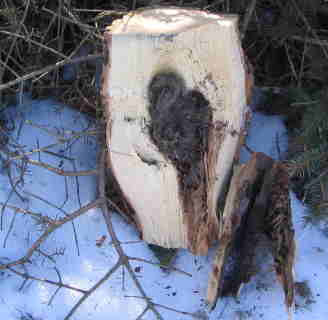![]() Observation: The First Step in the Scientific Method
Observation: The First Step in the Scientific Method
To observe means to examine something and to notice the details. When people observe things, they often wonder
why it is that way or wonder what occurred. Scientists strive to answer that question. They make observations.
This is the first step of the scientific method.
Observations are also called data. There are two kinds of data.
- Qualitative data which are descriptions that do not have numbers.
There were many different kinds of trees, of various sizes, growing in the park.
One of the trees was enormous is an example of qualitative data.- Quantitative data are obtained by measuring and have numbers. Scientists use instruments (tools) to obtain numbers based data.
In conducting a tree survey in the local park , the scouts found that there were: 4 white pines, 2 blue spruce and one hemlock. They also counted 20 white oaks including 4 seedlings and 6 saplings, as well as two sugar maples. By using proportion and scale , they determined 1 sugar maple was 33 meters tall. It had a circumference of 525.25 cm. The second was 32 meters tall. These are examples of observations with quantitative data.
Practice observing by examining at this photo of a log from a tree that grew in Central Pennsylvania, USA.
Click here for a closer view. Use the Back Button of your browser to return to this web page.
1. Write your observations - one per line - on a piece of paper.
Make as many observations as you can.
2. Imagine - If you were standing in the scene:
What tools (instruments) might you use to gather quantitative data about what you are observing?
When I touched the stuff, I observed it felt soft.
3. Form a question about what you have observed.
4. Prediction - Would you expect to see this again in another tree? Explain.
Extend your knowledge:
About Units of Measurement - IB Biology | Observing Biology how to's | Temperature facts and figures - IB Biology
Steps of the Scientific Method - Science Buddies | Learn about the Scientific Method Activity
Observation Skills Builders | What is a hypothesis?
Milkweed and Monarch Butterfly Mania Journal Entry | Learn about the Scientific Method | Bluebirds Project
Fields, Meadows & Fencerows EcoStudy | Wetlands EcoStudy Unit | Water & Watershed Study Unit
Habitat Project Digital Science Journal | Energy & Alternative Energy Studies | Plants & People | Milkweed & Monarch Butterflies Mania
Biodiversity Exploration Investigation | Ecology Community Status in your State's Ecosystem | Lentic and Lotic Ecosystems
Environmental Inquiry | PA Standards Aligned Systems
Science Links and Resources | Science NetLinks | iTunes U - free resources | Chem4Kids | Exploring the Environment modules and activities
![]()
All trademarks, copyright and logos belong to their respective owners.
Internet Hunts / Nature / Water / Computers / Famous Pennsylvanians / Civics & History / Puzzles & Projects / Site map / Home
Posted
by Cynthia J. O'Hora 2/2009, released for noncommercial use by nonprofit organizations
Aligned
with Pennsylvania Academic Standards | Assessment and Rubrics
Pennsylvania Academic Standards - The Nature of Science
Processes, Procedures and Tools of Scientific Investigations
• Apply knowledge of scientific investigation or technological design in different contexts to make inferences to solve problems.
• Use evidence, observations, or a variety of scales (e.g., time, mass, distance, volume, temperature) to describe relationships.
![]() Save a tree use a digital answer format - Highlight the text. Copy it. Paste it in a word processing document. Save the document in your folder. Answer on the wp document in an easily read, contrasting color or font. (Not yellow ) nor fancy fonts like: Symbols, Techno,
Save a tree use a digital answer format - Highlight the text. Copy it. Paste it in a word processing document. Save the document in your folder. Answer on the wp document in an easily read, contrasting color or font. (Not yellow ) nor fancy fonts like: Symbols, Techno, ![]() fancy fonts). Save frequently as you work. I have never liked losing my work. You will not like it either. Be sure to enter your name & the date at the top of the document in a header. Submit via email attachment or an electronic class dropbox. Bad things happen: Save a copy of the response document for your records.
fancy fonts). Save frequently as you work. I have never liked losing my work. You will not like it either. Be sure to enter your name & the date at the top of the document in a header. Submit via email attachment or an electronic class dropbox. Bad things happen: Save a copy of the response document for your records.
Proof your responses. It is funny how speling errors and typeos sneak in to the bets work. ![]() Make your own printer paper answer sheet
Make your own printer paper answer sheet
